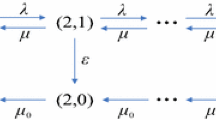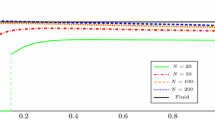Abstract
This paper considers a two-server rational random-access system with loss that receives requests on a time interval [0, T]. The users (players) are sending their requests to the system; then the system provides a random access with given probabilities to one of two free servers or to a single free server, or rejects the request. We study the following noncooperative game for this service system. As his strategy, each player chooses the time to send his request to the system, trying to maximize the probability of service. The symmetric Nash equilibrium is selected as the optimality criterion. Two models are considered for this game. In the first model, the number of players is deterministic, while in the second it obeys the Poisson distribution. We demonstrate that there exists a unique symmetric equilibrium for both models. Finally, some numerical experiments are performed (a) to compare the equilibria under different parameter values and (b) to compare the efficiency of this two-server system with the one-server counterpart and also with the corresponding pure random-access model in which the system has no information about the states of servers (busy or free).








Similar content being viewed by others
Change history
10 February 2021
An Erratum to this paper has been published: https://doi.org/10.1134/S0005117920120103
References
Mazalov, V. V. & Chuiko, Yu. V. Noncooperative Nash Equilibrium in an Optimal Arrival Time Problem for Queuing System. Vychisl. Tekhnolog. 11(no. 6), 60–71 (2006).
Chirkova, Yu. V. Optimal Arrivals in a Two-Server Random Access System with Loss. Autom. Remote Control 78(no. 3), 557–580 (2017).
Altman, E. Applications of Dynamic Games in Queues. Adv. Dynamic Games 7, 309–342 (2005).
Altman, E., A Markov Game Approach for Optimal Routing into a Queueing Network, INRIA Report no. 2178, 1994.
Altman, E., Hassin, R.Altman, E., Hassin, R., Non-Threshold Equilibrium for Customers Joining an M/G/1 Queue, Proc. of 10th Int. Symp. on Dynamic Game and Applications, Saint-Petersburg, 2002.
Altman, E., Jimenez, T., NunezQueija, R. & Yechiali, U. Optimal Routing among ⋅ /M/1 Queues with Partial Information. Stoch. Models 20(no. 2), 149–172 (2004).
Altman, E. & Koole, G. Stochastic Scheduling Games with Markov Decision Arrival Processes. J. Comput. Math. Appl. 26(no. 6), 141–148 (1993).
Altman, E., Shimkin, N.Individually Optimal Dynamic Routing in a Processor Sharing System, Operat. Research, 1998, pp. 776–784.
Glazer, A. & Hassin, R. Equilibrium Arrivals in Queues with Bulk Service at Scheduled Times. Transport. Sci. 21(no. 4), 273–278 (1987).
Glazer, A. & Hassin, R. ?/M/1: On the Equilibrium Distribution of Customer Arrivals. Eur. J. Operat. Research 13(no. 2), 146–150 (1983).
Johnson, O. & Goldschmidt, C. Preservation of Log-Concavity on Summation. ESAIM: Probab. Statist. 10, 206–215 (2006).
Killelea, P. Web Performance Tuning: Speeding Up the Web. (O’Reilly Media, Sebastopol, 2002).
Kopper, K. The Linux Enterprise Cluster: Build a Highly Available Cluster with Commodity Hardware and Free Software. (No Starch Press, San Francisco, 2005).
Ou, Z., Zhuang, H., Lukyanenko, A., Nurminen, J., Hui, P., Mazalov, V. & Yla-Jaaski, A. Is the Same Instance Type Created Equal? Exploiting Heterogeneity of Public Clouds. IEEE Trans. Cloud Computing 1(no. 2), 201–214 (2013).
Ravner, L. & Haviv, M. Strategic Timing of Arrivals to a Finite Queue Multi-Server Loss System. Queueing Syst. 81(no. 1), 71–96 (2015).
Ravner, L., Haviv, M.Equilibrium and Socially Optimal Arrivals to a Single Server Loss System, in Int. Conf. on Network Games Control and Optimization 2014 (NETGCOOP’14), Trento, Italy, October 2014.
Shaked, M. & Shanthikumar, J. G. Stochastic Orders, Springer Series in Statistics. (Springer, New York, 2007).
Author information
Authors and Affiliations
Corresponding author
Rights and permissions
About this article
Cite this article
Chirkova, Y. Optimal Arrivals in a Two-Server Rational Random-Access System with Loss. Autom Remote Control 81, 1345–1365 (2020). https://doi.org/10.1134/S0005117920070140
Received:
Revised:
Accepted:
Published:
Issue Date:
DOI: https://doi.org/10.1134/S0005117920070140




